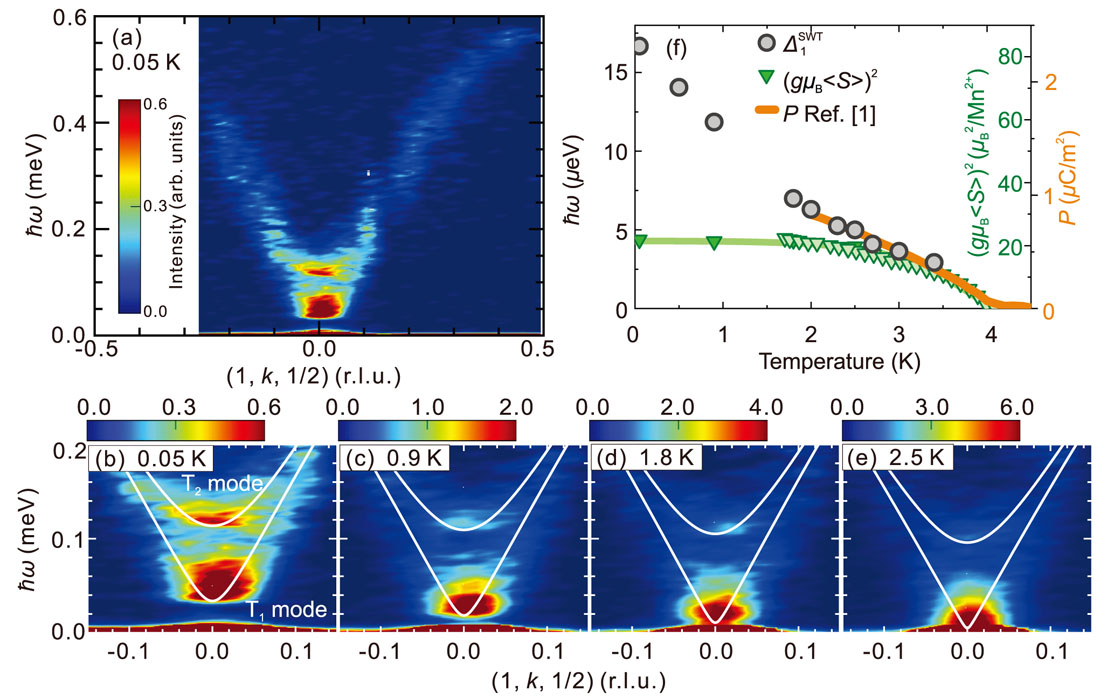Nontrivial Temperature Dependence of Magnetic Anisotropy in Multiferroics Ba2MnGe2O7
Masuda group
Spin-driven multiferroics have been extensively studied since the discovery of an enhanced magnetoelectric effect in TbMnO3. Through spin-orbit coupling (SOC), a spin order induces a change of charge distribution, leading to emergence of electric polarization. The microscopic mechanisms of the multiferroics are categorized into three types: the spin current, the exchange striction, and the spin dependent d-p hybridization. A notable feature of the third one is that hybridized d and p orbitals of magnetic ion and ligand are modulated by spin states via SOC, and this induces an electric polarization. The relation between the electric polarization P and the spin moment S is locally described. The mechanism has been identified in several compounds including åkermanite compounds Ba2CoGe2O7. Since the direction of the local spin moment determines the direction of the electric polarization, magnetic anisotropy plays a key role in forming multiferroic structure, i.e., the simultaneous structures of the spin and polarization. The magnitude of the anisotropy gives the energy scale for the control of the magnetism by the electric field as well as magnetic field. Although the temperature (T) dependence of the anisotropy gap in magnon spectrum in a conventional magnet scales as a power of the sublattice magnetic moment, it may not be the case for the multiferroics. The change of the polarization with T affects the spin-interaction parameters through the d-p hybridization, which can lead to a nontrivial behavior in T dependence of the anisotropy and a low-energy spin dynamics. Here we study spin dynamics on a square-lattice antiferromagnet Ba2MnGe2O7 known as multiferroic compound by using a state-of-art spectrometer with ultra-high resolution.
Figure 1(a) shows the INS spectrum measured at 0.05 K. Two dispersive modes with the boundary energy of 0.55 meV and with gaps ~ 0.05 meV and ~ 0.1 meV are clearly observed. The gap of the low-energy (T1) mode is ascribed to easy-axis anisotropy in the square lattice by spin nematic interaction/electric polarization interaction;
![]() N = ∑i,jJNOiXYOjXY = ∑i,jJPPiZPjZ, where JN is nematic interaction, OXY is Stevens operator, and JP is an effective interaction between the electric polarizations. Anisotropy gap of the high-energy (T2) mode is ascribed to easy-plane anisotropy by a single-ion anisotropy. We find that the former gap is drastically suppressed with the increase of T, while the latter gap is moderately suppressed as shown in Figs. 1(b)-1(e). We also find that JN is strongly dependent on T.
N = ∑i,jJNOiXYOjXY = ∑i,jJPPiZPjZ, where JN is nematic interaction, OXY is Stevens operator, and JP is an effective interaction between the electric polarizations. Anisotropy gap of the high-energy (T2) mode is ascribed to easy-plane anisotropy by a single-ion anisotropy. We find that the former gap is drastically suppressed with the increase of T, while the latter gap is moderately suppressed as shown in Figs. 1(b)-1(e). We also find that JN is strongly dependent on T.

Fig. 1. Inelastic neutron scattering (INS) spectra. (a) False color plot of the INS spectrum measured at 0.05 K projected onto the ħω - (1, k, 1/2) plane. The spectrum is integrated in the range of 0.9 ≤ h ≤ 1.1 and 0.45 ≤ l ≤ 0.55. White solid curves are calculated magnon-dispersions. (b)-(e) The INS spectra focused on the low-energy range measured at (b) 0.05 K, (c) 0.9 K, (d) 1.8 K and (e) 2.5 K. White solid curves are calculated dispersions. (f) T dependences of ∆
T dependences of the easy-axis anisotropy ∆![]() N exhibits that the formula of the anisotropy gap is proportional to P. Furthermore, the calculation shows that the drastic T dependence of JN results from the change of orbital with T; the modification of the hybridized orbitals of Mn2+ and O2− ions with T leads to a small change of the energy, which is negligible in highly anisotropic system but is enhanced in the nearly isotropic system such as the symmetric half-filled shell of Mn2+ ion, and it is probed as the change of JN thorough SOC. We, thus, find a characteristic quasiparticle of the multiferroics originating from the hybridization of spin and orbital momenta.
N exhibits that the formula of the anisotropy gap is proportional to P. Furthermore, the calculation shows that the drastic T dependence of JN results from the change of orbital with T; the modification of the hybridized orbitals of Mn2+ and O2− ions with T leads to a small change of the energy, which is negligible in highly anisotropic system but is enhanced in the nearly isotropic system such as the symmetric half-filled shell of Mn2+ ion, and it is probed as the change of JN thorough SOC. We, thus, find a characteristic quasiparticle of the multiferroics originating from the hybridization of spin and orbital momenta.
References
- [1] H. Murakawa, Y. Onose, S. Miyahara, N. Furukawa, and Y. Tokura, Phys. Rev. B 85, 174106 (2012).
- [2] S. Hasegawa, S. Hayashida, S. Asai, M. Matsuura, I. Zaliznyak, and T. Masuda, Phys. Rev. Research 3, L032023 (2021).
